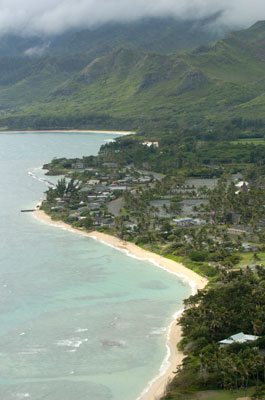Housing project generates strife

The city released a five-year review of the Koolauloa sustainable communities plan yesterday along with the North Shore sustainability plan.



City officials released yesterday a new vision for Koolauloa that includes plans to rezone agricultural land north of Brigham Young University-Hawaii to allow shops, churches and hundreds of homes under a proposal that has divided the tightly knit Laie community.
BYUH’s Envision Laie Development would bring badly needed affordable housing that proponents say would help keep young North Shore residents home, while helping to attract potential new industries that could create jobs outside the university and its Polynesian Cultural Center.
Opponents say that Kamehameha Highway — the only way into and out of the area — is already congested and that there is not enough water and sewer capacity to handle any more development.
"In public meetings, people have been divided pretty close to 50-50," said David Tanoue, director of the city Department of Planning and Permitting. "Clearly we won’t reach consensus, so we decided to push it out the door and vet it more openly and more publicly."
Officials with Hawaii Reserves Inc., which manages and owns property affiliated with the Church of Jesus Christ of Latter-day Saints, were still trying to figure out yesterday what the city’s newly released sustainable communities plan for Koolauloa means for their Envision Laie Development and where the boundaries for the project would lie.
Hawaii Reserves Inc. originally proposed rezoning 900 acres of agricultural land mauka of Malaekahana State Recreation Area, of which about one-third would be used for the project, said Jace McQuivey, vice president and general legal counsel for Hawaii Reserves Inc.
Don't miss out on what's happening!
Stay in touch with breaking news, as it happens, conveniently in your email inbox. It's FREE!
The original plan called for 1,200 residential units and an unspecified number of churches, shops and a general expansion of BYUH to allow the university to grow to 5,000 students from 2,400, McQuivey said.
The plan was later scaled back to 875 units. But Hawaii Reserves officials were studying the city’s plan yesterday to figure out more precise limits on the project.
The area is currently zoned for agriculture and would have to be rezoned to allow residential, commercial and industrial mixed use, Tanoue said.
Community meetings are tentatively planned for sometime in November, with subsequent public hearings before the Planning Commission and City Council, which would have ultimate approval, Tanoue said.
The city released the five-year review of the Koolauloa sustainable communities plan yesterday along with the North Shore sustainability plan.
They are among several community plans that city planners have worked on for years and have recently unveiled.
"It’s a five-year review that’s 10 years too late," Tanoue said. "We took on a Herculean task of trying to bring them all up to date. When we (former Mayor Mufi Hannemann’s administration) came on board, everything was behind schedule."
The plan for Koolauloa covers an area that stretches from Koolaupoko to Kawela. But it is the Envision Laie Development component that has "split the community," Tanoue said.
K.C. Connors believed the city’s sustainability plan "was supposed to keep the country country," she said. "To our surprise, they had approved this massive Envision Laie project that will double the size of BYU and create a whole new town that will make the North Shore look like Mililani."
But Choon James, another opponent of the plan, was more moderate yesterday.
"It’s not going to be as big as Mililani, but we really can’t get our hands on any details," James said. "The lack of transparency is very troublesome. To put a new community here goes against the general plan."
James and other members of the area’s Planning Advisory Committee attended a meeting with Tanoue on Wednesday in which he said the proposal was moving forward after he had met with representatives from BYUH and Hawaii Reserves.
"I was quite taken back by how upfront he was in telling us that he had been meeting many, many hours and many days with Hawaii Reserves and the BYU-Hawaii campus outside of the PAC committee meetings," James said. "That’s the role of the PAC. Why be so devious to meet outside the PAC committee? It subverts the public process."
In 2009 Heart + Mind Strategies, in conjunction with Hawaii-based OmniTrak Group Inc., surveyed Koolauloa residents and found that:
» More than four in 10 had family members that moved away because they could not find a job or an affordable place to live in Koolauloa.
» Fifty-two percent believed that future growth in the region will make things better, compared with 41 percent who said growth would make things worse.
Pane Meatoga, 52, saw his son, daughter-in-law and three grandchildren move to the Rancho Cordova area of Northern California two years ago because of a lack of good-paying jobs and affordable housing in Koolauloa.
Meatoga was born and raised in Laie. His son, Neil, has both bachelor’s and master’s degrees.
But Neil and his family had to move in with Pane.
"They couldn’t afford anyplace else," Pane said. "Now he lives in a home that’s a whole lot bigger than what I have and a whole lot nicer."
As president of the Laie Community Association, Pane said, "We’ve been trying to get affordable housing and more jobs in the countryside for the last 15 to 20 years. This Envision Laie project allows us to attract other industries beyond PCC and BYU-Hawaii. And this gives us hope to keep our families here in the community."



